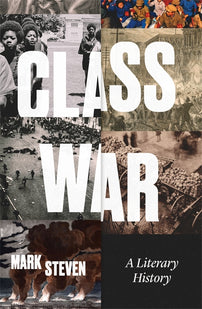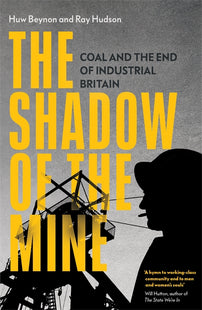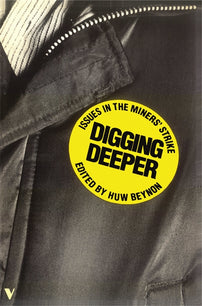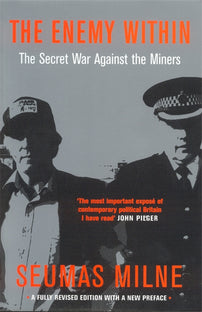Choose your side. Choose your weapons
Published 20 years after the 1984-85 miners' strike that it portrays, David Peace's kaleidoscopic novel GB84 depicted the affective realities of the struggle as it was fought by pickets, policemen. Alexander Curtis asks what the literature can teach us about the past and present of class war.
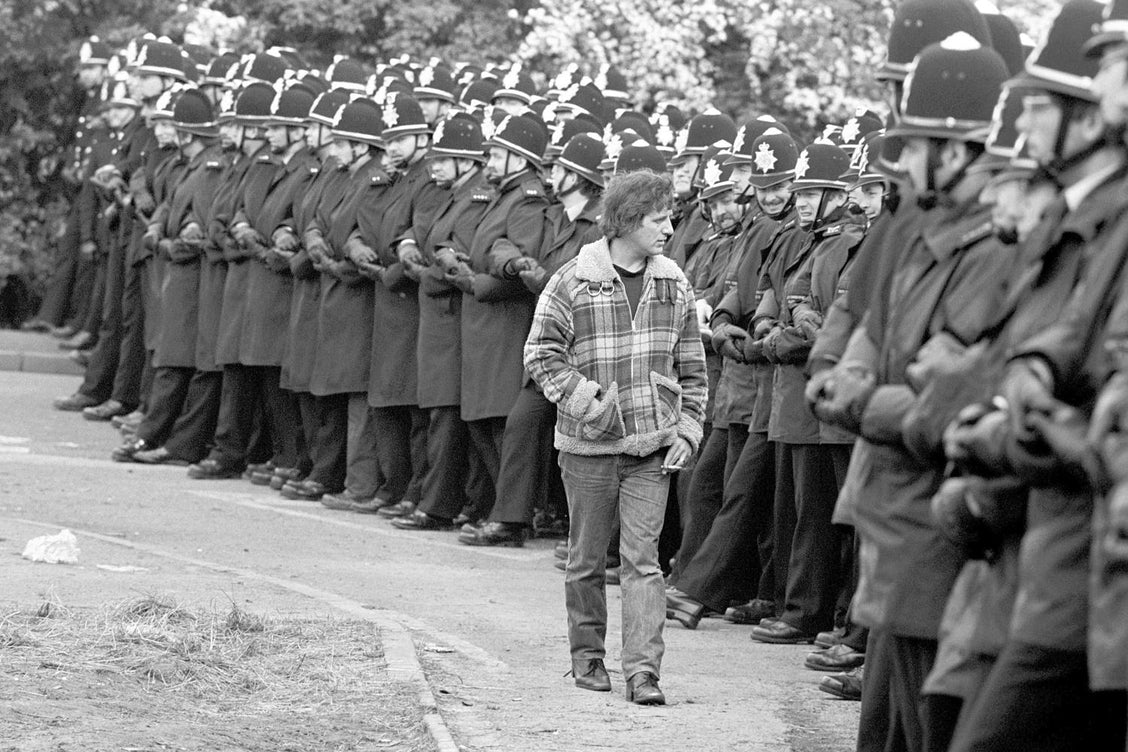
Terry Winters, one of many narrators in David Peace’s GB84, and a proxy for Roger Windsor, the Chief Executive of the National Union of Mineworkers during the strikes, does not share Arthur Scargill’s taste in literature. “The President loved Paris,” we read. “Revolutionary City. Second only to Leningrad. Holy City. The President loved the bread. The cheese. The good coffee. The red wine. The President carried Zola everywhere. Germinal. Terry had a copy too. He couldn’t get into it.”
If Scargill, the president of the NUM, pictured himself carving out a new history to stand alongside that recounted by his favourite novelist Émile Zola, then Terry’s concerns are far more prosaic. Germinal, Zola’s story of the NUM’s antecedents in nineteenth-century France, offers little escape from his present aggravations:
Terry threw it across the hotel room. He hadn’t slept. He couldn’t—
The President and the fucking Frogs had bloody left Terry in town after lunch. The President and Joan had their own plans for the rest of the day. The evening—
Plans in which Comrade Terry had not been included.
Nor is it just Zola’s class war that Terry rejects. Gone too is “comrade”, the word hardly appearing in Terry’s narration, only in dialogue. There, though, it is dripping with bitterness. While Terry’s treatment is distinctly uncomradely, he disdains the word and its connections. But it is precisely these connections that are important for the word’s advocates: it renders the war being waged by the NUM coterminous with the historical, from open warfare fought with pikes and pistols in the Paris Commune to Leningrad and beyond. It potentiates the revolutionary act and concretises the oppositionality of warfare: they are Comrades in the war against Margaret Thatcher.
Peace’s kaleidoscopic novel was released twenty years after the 1984-85 miners’ strike but, through cut-up narrative and a wide cast of narrators, it went some way to depicting the affective realities of the struggle as it was fought by pickets, policemen, and political agitators alike. As Mark Steven’s Class War: A Literary History shows, novelistic representations and literary artefacts of historical class struggle can furnish historically significant insights into the history of class struggle. Peace’s representations of class war, alongside the texts left behind by Arthur Scargill and Margaret Thatcher, can help us to get a little closer to an understanding of the literary dimensions of the struggle, and the ways in which the battle was won and lost.
“Class is forged not only through exploitation and dispossession,” Steven argues, “but also through antagonism—and through that antagonism, class is remade into something revolutionary.” By tracing the ways in which literature has fuelled this antagonism, Stevens conducts a literary history of class war’s shape.
[book-strip index="1"]
The first recorded use of the word in England, Stevens tells us, “appeared on 25 January 1840 in Northern Star. It came at the end of an article setting out the movement’s positions and demands, which pronounces ritual bloodletting as the outcome of underrepresentation coupled with immiseration. ‘Good must come to the nation out of this class warfare for pre-eminence,’ it reads ‘as from a compound of the most deadly poisons a wholesale medicine may be extracted.’” Literature has provided both the resources and the tools with which class war is waged, as well as the capacity to unite the working class through common language and to fan the flames of that crucial component of revolution: antagonism. As Mark Fisher said: “Choose your side. Choose your weapons.” Which weapons were chosen by Arthur Scargill, and which by his antagonist, Margaret Thatcher?
The elections of Thatcher and Ronald Reagan were followed by a refusal of détente, and a renewed vigour for the rollback and dissolution of the Soviet Union. Whether the miners liked it or not, they were to play a part in this. Allusions were drawn by their opponents: as Seumas Milne points out in The Enemy Within, “even the left-of-centre New Statesman managed to compare the NUM to the ‘oppressive regimes’ then falling like dominoes in Eastern Europe.” The plight of the miners was recast as an insurgent infiltration of Soviet ideology, with Scargill a manifestation of an Eastern Bloc bent on the destruction of the post-war consensus. They were, as Thatcher famously put it, an “Enemy Within.”
The working class was enervated during the 1980s by economic transitions which broke down the links between workers, found in language and solidarity. Steven points to the difficulty of a “reading of class composition at the time of transformation, when the industrial proletariat of the nineteenth and early twentieth century had given way to new forms of social being which had not cohered into a revolutionary class… a world in which all social relations are mediated by the wage.” Class relations had deteriorated in the 1970s, “the collective ‘we’ and ‘our’ to the atomized ‘I’ and ‘my’–from the class back to the individual.” Thatcher sought to capitalise on this, applying stress to the fractures in the society with a Cold War language of espionage and infiltration, to which the historical language of pickets, strikes, and revolutions would prove desperately unequal. The strikes would eventually fail in March 1985, three days short of a year after they had begun. The demands of the miners went unmet. Many pits were to close in the years that followed.
In 1984, Scargill attended a rally in Rother Valley, South Yorkshire, and his speech, read closely, reveals some of the fundamental weaknesses of his weapons of choice. “You can come forward with all the platitudes that you want,” he said.
You can give expressions of solidarity from a platform. They are meaningless, unless you carry out the basic tenet and principle of the British labour and trade union movement. And I say it to the leaders of the SDC, and I say it to the leaders of the WPTU: when you come up against a picket line, you do not cross it.
The strike, for Stevens, is a gesture which has historically “demonstrate[d] that workers are the irreplaceable agents of production”, and which helped to consolidate the class in unity. But concealed within Scargill’s speech was the frailty of his campaign. The invocation of the sacrosanctity of the picket line and its association with the labour and trade union movement, intoned repeatedly by Scargill and his comrades, contains desperation. “You do not cross it”: an inevitability, so it has been, so it will always be; a rite of class. Yet many strikebreakers did cross the picket. As Stuart Hall noted, it was not “a ‘class-versus-class showdown’ because, far from ‘the class’ being united, it was deeply divided … the strike was dominated, and ultimately defeated, precisely by the splits and divisions which our ritualistic commitment to the formulae of ‘class politics’ prevented us from seeing.” By 1984, something had changed in class and labour relations, and Scargill did not see it.
[book-strip index="2"]
Thatcher, though, could. She inverted that other revolutionary slogan of the NUM—“The miners united would never be defeated”—and turned it back on to them. Her strategy was to heighten the existing stresses in the class facade to the point of rupture. Her tools were those of espionage and infiltration. As Nigel Lawson, then Chancellor of the Exchequer, said: “most Prime Ministers have a soft spot for the security services, for which they have a special responsibility. But Margaret, an avid reader of the works of Frederick Forsyth, was positively besotted by them”. Forsyth, a journalist and ex-informer of MI6, was famous for writing spy thrillers, and by 1984 the ranks of the security services dedicated to fighting the war against the miners had swollen tenfold, including “a small army of handlers, agents and informers”, per Milne. Thatcher’s “Get Scargill” campaign was run by MI5 and Special Branch, whose “policemen dressed as pickets” deployed a host of “dirty tricks” and provoked “violent incidents.”
The goal of this was to paralyse the NUM with paranoia and suspicion. Peace’s novel captures its quality: “There’s rumours that scabs are giving names of blokes on strike in Notts to police. Their addresses. Police giving names to these hit squads. Hired hands. Lads getting ambushed. Wives getting dirty calls when men are out picketing. Heavy breathing—I’ve told Cath to keep chain on when I’m out.” The structure of Peace’s novel reflects the discord sown among the NUM: it is an often-opaque narrative of many voices, whose halting accounts are paused without regard for the traditional beats of story. Reading it, one is often at sea among acronyms and historical proxies. It is hard to know who is on who’s side, and impossible to trust the actions or accounts of the characters.
Just as Thatcher described the miners as the “Enemy Within”, so she had them feverishly searching their ranks for enemy infiltration. Class unity became impossible to maintain even at the highest rank. Chief Executive of the NUM, Roger Windsor (Peace’s Terry Winters) appeared on ITV’s 1990 exposé, The Cook Report, to disseminate stories about the relationship between the NUM and Colonel Gadaffi. He would do so in fanciful, even Forsythian terms, with tall tales of briefcases stuffed with Libyan cash being smuggled through British customs, stored in biscuit tins, and used to pay off the mortgages of the senior members, including Scargill. The imagery here is grubby. As Milne shows, The Cook Report’s “elaborate reconstruction of the handovers of Libyan cash…the trips back and forth to Tripoli, the briefcases full of money, the miraculous airport encounters with customs officers... [were] a complete fabrication.” It wasn’t enough that money had been transferred: in order to induce the appropriate paranoia and hysteria among the public it had to be smuggled in briefcases past rows of airport fiction in whose pages similarly exploits are imagined. The affair would be ruinous for Scargill. True to the spy narrative, it later emerged that Windsor had been involved with Deputy Director (later, Director General) of MI5, Stella Rimington.
It would be the Battle of Orgreave that would demonstrate the differing tactics of the two sides in the war. Orgreave was not a mine but at a coking plant in Yorkshire, and the violence there was known to be a contrivance of the Thatcher government’s campaign, seen by many as the final nail in the strike’s coffin. In the Guardian, David Conn wrote that one of the gestural features of the picket line was the “ritual push”, “where miners would make a show of trying to push through police lines, without expecting that they would succeed; the police would hold the line, then relative calm would prevail again. But at Orgreave, the police did not just stand firm… they responded with mounted charges into the crowd, and with truncheons.” A narrator from Peace’s novel describes it like a medieval scene: “Pitch fucking battle now. Ten thousand men kicking the living fuck out of each other—Like something from bloody Middle Ages. Dark Ages. Three of us just stand there—Mouthfuls of sausage roll. Shitting fucking bricks.” These men were tragically unprepared for the battle which would be waged against them. David Hart, an activist and financier close to the Thatcher government, later admitted: “It was a battle ground of our choosing on grounds of our choosing… the fact is that it was a set-up and it worked brilliantly.”
Why? One picket told Conn: “We were all guided in, told where to park, led into that field. That makes us believe it was pre-planned to get us there, and give us a hiding.” That’s one answer: that Thatcher by this late stage in the struggle simply wanted to inflict violence. But the violence wasn’t merely physical, it was symbolic. Per Milne, Scargill had canvassed Orgreave as “a potential rerun of the miners’ victory at Saltley in 1972, and a way of galvanising the labour movement.” Scargill’s nostalgia for historical struggle was to be exploited here by Thatcher. As Hall wrote, “Saltley Gate was a heroic moment: but there is no automatic button marked ‘Destruct Mrs Thatcher’. To believe this is not to build on an understanding of, but to be transfixed by the past.” Thatcher’s symbolic violence was to create a rupture between contemporary struggle and the battles of the past, in which men had heroically remained firm in the face of state aggression. As Hall wrote: “The miners were offered three reasons for supporting the strike: in memory of those who had built up the union; for their families; and ‘as men’, who have a duty to stand up and fight. Glowing sentiments. And yet, in their backward trajectory, their familial and masculinist assumptions; those words fall on my ears as archaic. The cause is correct. The language is a dying one.”
[book-strip index="3"]
There is a bitterly ironic sense of predetermination to Scargill’s resuscitation of the strategies and language of Zola’s Paris in the nineteenth-century. As Hall summarised, “the strike was thus doomed to be fought and lost as an old rather than as a new form of politics… it was a major engagement with Thatcherism which should have marked the transition to the politics of the present and future, but which was fought and lost, imprisoned in the categories and strategies of the past.” Yet this is only half the picture. Hall correctly reads the strategies of the miners in historical terms but, following Stevens, it is important to balance the antagonistic equation. By pioneering these new tactics of labour oppression, Thatcher was in fact creating a new politics; it was the destruction of the strikes which consolidated the power of the new Thatcherism, which would thrive on the perpetuation of disunity among the working class. The language has been wielded by the political establishment ever since. Workers are constantly reminded of the inconvenience they face as a result of transport strikes. Smear campaigns are consistently deployed against the reemergent trade union movement, with figures such as Mick Lynch and Eddie Dempsey consistently targeted with language which seeks to align them to the struggles of the past, and even to the Kremlin. It remains to be seen whether the labour and trade union movement will draw upon a literary toolkit which resonates with the public strongly enough to consolidate the class in both unity and antagonism.
Alexander Curtis is a writer and critic from Leicester. He is working on a PhD in English Literature at the University of Nottingham.
